| React知识中一个主要内容便是组件之间的通信,以下列举几种常用的组件通信方式,结合实例,通俗易懂,建议收藏。
一、父子组件通信原理:父组件通过props(与vue中的props区分开)向子组件通信,子组件通过回调事件与父组件通信。 首先,先创建一个父组件Parent.js跟子组件Children.js,二者的关系为直接父子关系。 Parent.js父组件如下,给父组件一个默认状态state,引入子组件,通过在子组件加上toChildren={this.state.msg},该处即为向子组件传props。 import React from 'react';import { Button } from 'element-react';import Children from './Children'; class Parent extends React.Component { constructor(props) { super(props); this.state = { msg:'父组件传递给子组件' }; this.changeMsg = this.changeMsg.bind(this) } changeMsg(){ this.setState({ msg:'父组件传递给子组件(改变之后的内容)' }) } render(){ return ( <div style={{backgroundColor:'#f7ba2a',padding:'20px',width:'500px',margin:'auto',textAlign:'center'}}> <p>父子组件通信实例</p> <Button onClick={this.changeMsg}>父传子</Button> <Children toChildren={this.state.msg}></Children> </div> ) }} export default ParentChildren.js子组件如下,初始状态通过props拿到父组件传过来的值。 import React from 'react'; class Children extends React.Component { constructor(props) { super(props); this.state = { msg:this.props.toChildren //通过props拿到父组件传过来的值 }; } render(){ return ( <div style={{backgroundColor:'#13ce66',padding:'10px',width:'200px',margin:'auto',marginTop:'20px'}}> <p>从父组件传过来:</p> <span style={{color:'blue'}}>{this.state.msg}</span> </div> ) }} export default Children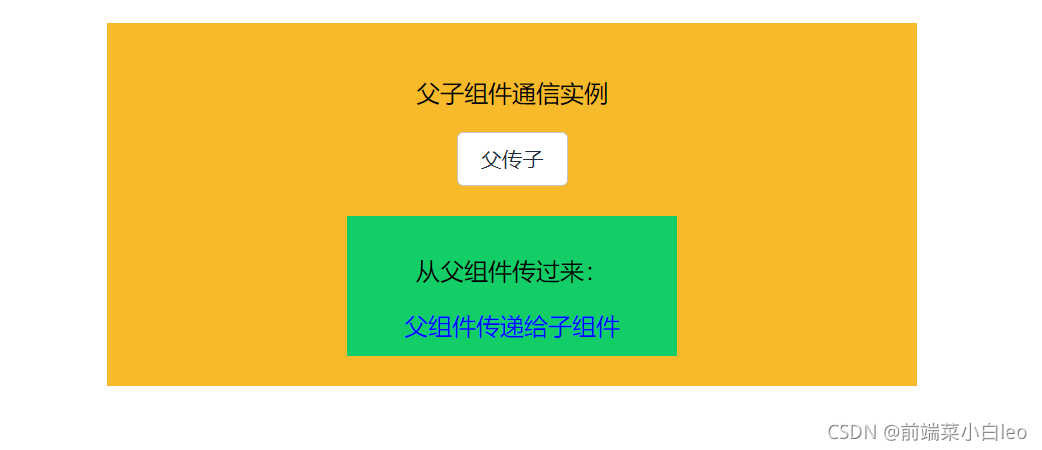
注意:子组件取值时应与父组件放在子组件的字段props一致,即本例中的 toChildren,如下 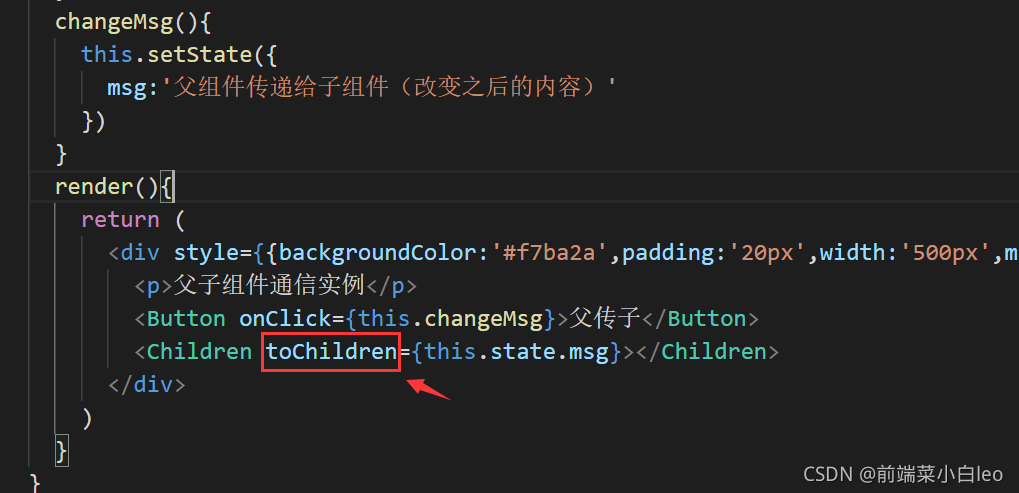

那么子组件想向父组件传值(向上传值),可以通过调用父组件传过来的回调函数 在Parent.js中向Children.js中加入回调函数callback,绑定changeMsg方法 import React from 'react';import Children from './Children'; class Parent extends React.Component { constructor(props) { super(props); this.state = { msg:'父组件传递给子组件', fromChildrn:'' }; this.changeMsg = this.changeMsg.bind(this) } changeMsg(val){ this.setState({ fromChildrn: val }) } render(){ return ( <div style={{backgroundColor:'#f7ba2a',padding:'20px',width:'500px',margin:'auto',textAlign:'center'}}> <p>父子组件通信实例</p> <span style={{color:'red'}}>{this.state.fromChildrn}</span> <Children toChildren={this.state.msg} callback={this.changeMsg}></Children> </div> ) }} export default Parent在子组件中,用this.props.callback()执行父组件的回调函数,从而执行绑定方法changeMsg,显示子组件传过来的值 import React from 'react';import { Button } from 'element-react'; class Children extends React.Component { constructor(props) { super(props); this.state = { msg:this.props.toChildren }; this.toParent = this.toParent.bind(this) } toParent(){ this.props.callback('子组件传过来的值') //子组件通过此触发父组件的回调方法 } render(){ return ( <div style={{backgroundColor:'#13ce66',padding:'10px',width:'200px',margin:'auto',marginTop:'20px'}}> <p>从父组件传过来:</p> <span style={{color:'blue'}}>{this.state.msg}</span> <Button onClick={this.toParent}>子传父</Button> </div> ) }} export default Children注意:props中的回调函数名称需一致,即本例中的callback,如下 
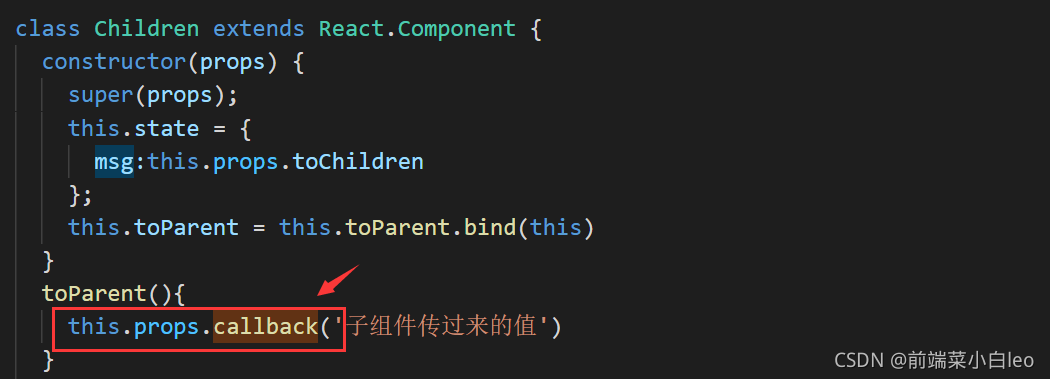
小结: 以上为直接父子组件通信的其中一种方式,父传子,通过props;子传父,执行回调。
二、跨级组件通信假设一个父组件中存在一个子组件,这个子组件中又存在一个子组件,暂且称为“孙组件”,当父组件需要与“孙组件”通信时,常用的方式有两种,逐层传值与跨层传值。
1、逐层传值这种方式就是上面的直接父子通信的基础上在加上一个中间层。如父、“孙”组件通信,可以先父子通信,然后再子“孙”通信,传递的层级变成父-->子-->“孙”,同理,通过props往下传,通过回调往上传。不展开,有兴趣的自己动手实现一下。
2、跨级传值顾名思义,父跟“孙”通信,不需要经过子(中间层)组件。这里引出了Context。 React官方文档对Context做出了解释: 在一个典型的 React 应用中,数据是通过 props 属性自上而下(由父及子)进行传递的,但这种做法对于某些类型的属性而言是极其繁琐的(例如:地区偏好,UI 主题),这些属性是应用程序中许多组件都需要的。Context 提供了一种在组件之间共享此类值的方式,而不必显式地通过组件树的逐层传递 props。 一句话概括就是:跨级传值,状态共享。 看下简单的实例,直接讲用法。 首先,我先创建一个context.js文件(与父子孙同个目录),默认值为一个对象。 import React from "react";const MyContext = React.createContext({text:'luck'});export default MyContext然后,对父组件进行改写,引入context,使用一个 Provider 来将当前的 value 传递给以下的组件树,value为传递的值。 import React from 'react';import Children from './Children';import MyContext from './context'; class Parent extends React.Component { constructor(props) { super(props); } // 使用一个 Provider 来将当前的 value 传递给以下的组件树。 // 无论多深,任何组件都能读取这个值。 render(){ return ( <div style={{backgroundColor:'#f7ba2a',padding:'20px',width:'500px',margin:'auto',textAlign:'center'}}> <p>context通信实例</p> <MyContext.Provider value={{text:'good luck'}}> <Children></Children> </MyContext.Provider> </div> ) }} export default Parent子组件为中间层,不做处理,用于包裹“孙”组件。 import React from 'react';import Grandson from './Grandson'; class Children extends React.Component { render(){ return ( <div> <Grandson></Grandson> </div> ) }} export default Children新增一个“孙”组件,同样需引入context,在组件内部添加static contextType = MyContext,此时将能通过this.context直接获取到上层距离最近的Provider传递的值,此时this.context = {text:good luck},即父组件传递value。 import React from 'react';import MyContext from './context'; class Grandson extends React.Component { static contextType = MyContext render(){ return ( <div style={{backgroundColor:'#13ce66',padding:'10px',width:'200px',margin:'auto',marginTop:'20px'}}> <p>通过context传过来:</p> <span style={{color:'blue'}}>{this.context.text}</span> </div> ) }} export default Grandson通过this.context.text获取到传递的值。 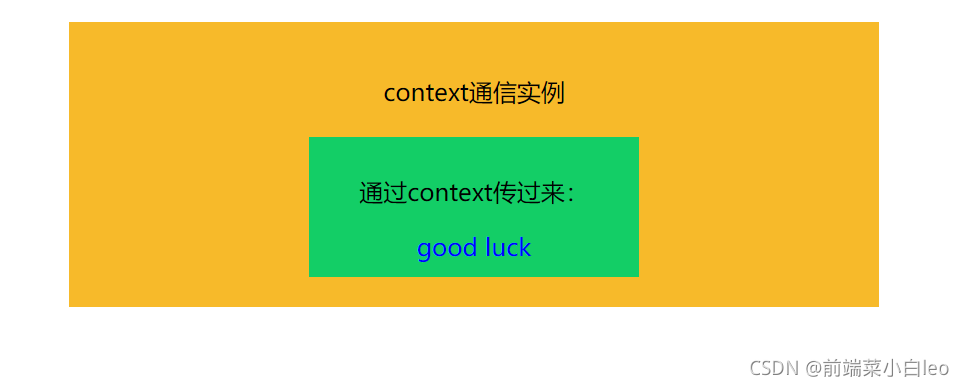
以上的是一个父-->孙的过程,即向下的流程,如果想孙-->父向上传值,可以通过回调的方式 对父组件进行传值修改,在传过来的对象中添加一个属性,里面绑定父组件的方法value={{text:'good luck',toParent:this.fromGranson}} import React from 'react';import Children from './Children';import MyContext from './context'; class Parent extends React.Component { constructor(props) { super(props); this.state = { msg:'' }; this.fromGranson = this.fromGranson.bind(this) } fromGranson(val){ this.setState({ msg:val }) } // 使用一个 Provider 来将当前的 theme 传递给以下的组件树。 // 无论多深,任何组件都能读取这个值。 render(){ return ( <div style={{backgroundColor:'#f7ba2a',padding:'20px',width:'500px',margin:'auto',textAlign:'center'}}> <p>context通信实例</p> <span style={{color:'red'}}>{this.state.msg}</span> <MyContext.Provider value={{text:'good luck',toParent:this.fromGranson}}> <Children></Children> </MyContext.Provider> </div> ) }} export default Parent然后在孙组件中添加一个按钮,绑定方法,执行函数回调 toParent(){ this.context.toParent('孙组件向父组件传数据') }import React from 'react';import MyContext from './context';import { Button } from 'element-react' class Grandson extends React.Component { static contextType = MyContext constructor(props) { super(props); this.toParent = this.toParent.bind(this) } toParent(){ this.context.toParent('孙组件向父组件传数据') } render(){ return ( <div style={{backgroundColor:'#13ce66',padding:'10px',width:'200px',margin:'auto',marginTop:'20px'}}> <p>通过context传过来:</p> <span style={{color:'blue'}}>{this.context.text}</span> <div><Button onClick={this.toParent}>context向上</Button></div> </div> ) }} export default Grandson默认的页面为: 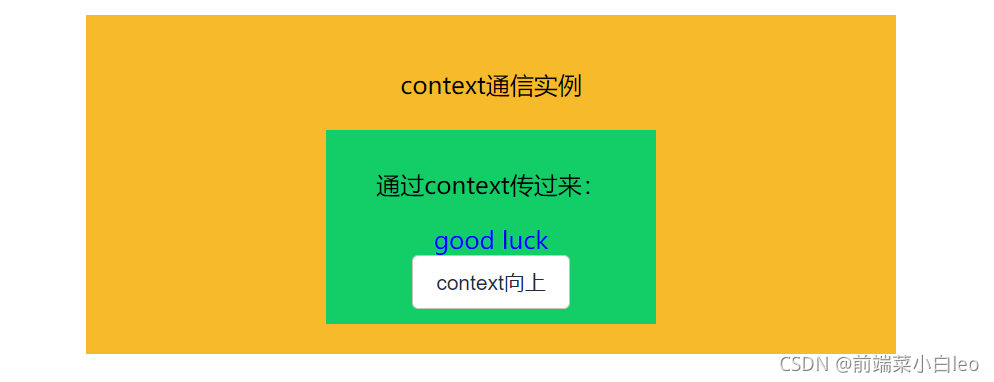
点击按钮之后,执行context中的回调,向上传值。 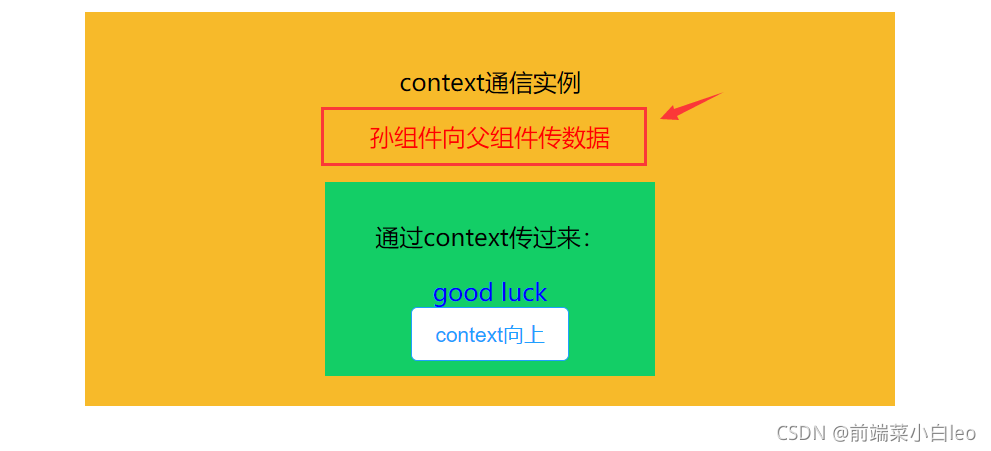
不管层级有多深,都可以使用context进行向下或向上传值。 注意:在下层组件中取的context中的字段需与value中传递字段保持一致。text与toParent 
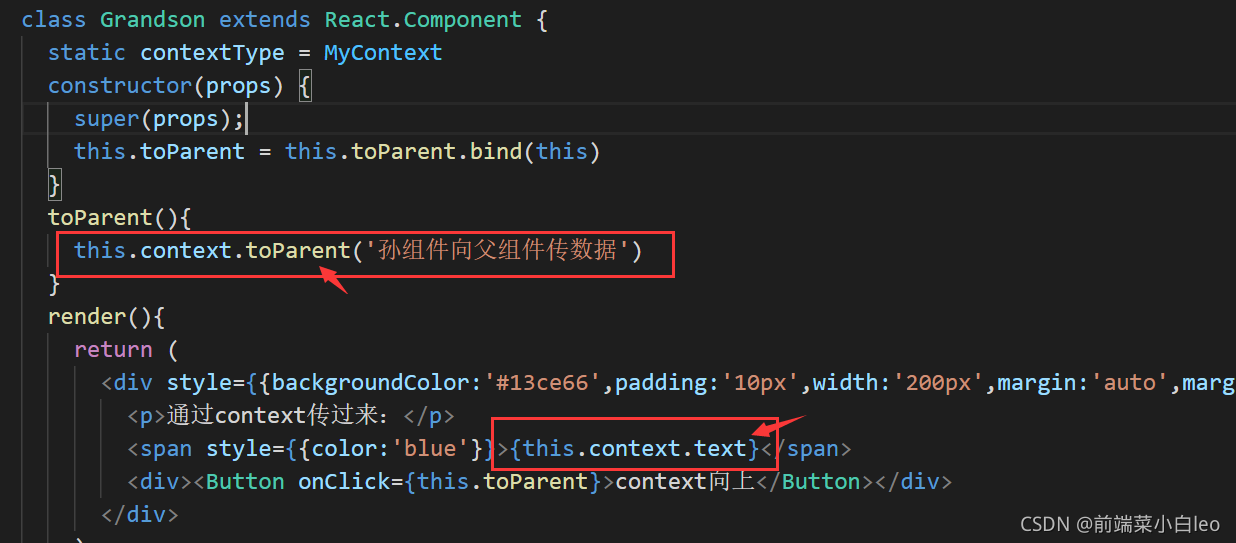
以上就是Context的大致使用,更多细节请往React官方文档: Context
下载地址:
详解 TypeScript 枚举类型
Vue实现组件间通信的几种方式(多种场景) |

